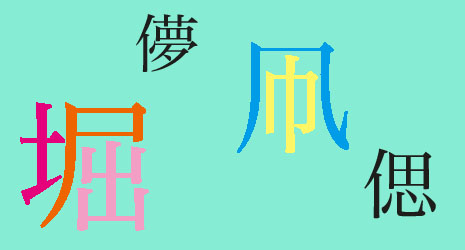Home > Highlighting JAPAN > Highlighting Japan February 2019 > Sharing Japanese Literature with the World
Highlighting JAPAN


How Kanji Capture Meaning and Emotion in a Single Character
Written Japanese uses three writing systems: kanji, hiragana, and katakana. Kanji characters are quite complex, with multiple meanings and various pronunciations. Professor Hiroyuki Sasahara, a kanji research specialist, shares the evolution of these characters as well as the logic and intricacies behind their meaning and appearance.
Kanji characters originated in China and spread to East Asian countries, with Japan assimilating the writing system by the fifth century. Hiragana and katakana—two simpler syllabic alphabets based on Kanji—were created in the ninth century. At first intellectuals read documents in Chinese and Korean, and only used kanji as a written language. According to Professor Hiroyuki Sasahara of Waseda University’s School of Social Sciences, however, Kanji began to evolve as people shaped the system to suit the Japanese language and pronunciation.
“Individual letters in the Roman alphabet basically only have one pronunciation, whereas Japanese kanji characters can be read in multiple ways,” Sasahara notes. “Since Kanji originally come from a different language, Japanese people had to match the equivalent sound with a similar meaning in Japanese. For instance, the character for mountain (山) was originally pronounced ‘san,’ while in Japanese it was changed to ‘yama.’ The character for life (生) also contains many meanings, and depending on the usage can be read as sei, shou, i, ha, u, nama or ki.”
Some characters were altered to suit the Japanese language, and others were created. For instance, in ancient times the character for “beech tree” was originally written as 橿. While retaining the tree (木) radical on the left-hand side, they replaced the other character with one that meant “firm” (堅) to represent the hardness of the wood, and so it became 樫. By the eighth century, it is clear from documents such as Muromachi Period (1336-1573) courtiers’ journals that other original Japanese Kanji also came into use. For instance, sardines are known as a fish (魚)that needs to swim in a school for protection and spoils easily, so they added the character for weak (弱) to the fish character to represent sardines (鰯). On the other hand, the codfish is known as a fish that is white as snow and delicious during the winter, so the character for cod (鱈) incorporates the character for snow (雪).
“Kanji in Japan are not just phonetic symbols—they portray a specific meaning or feeling through the character,” Sasahara explains. “Even when creating Kanji, the Japanese people preferred to combine characters to create new meanings—as demonstrated by the original characters for ‘beech tree’ and ‘cod.’ To describe the meaning of each character, people added their own way of reading characters that originated in China.”
Sasahara points out that Kanji also help express emotions. For instance, both 思 and 想 are read as omo, and mean “thought” or “thinking.” However, the latter is most frequently used when expressing thoughts of faraway family and lovers or when reminiscing about old times, loneliness and love.
“It’s common in literary works to use different Kanji to reflect emotion,” he adds. “There are also cases in which non-Japanese words are written out in kanji as well. The famous novelist Natsume Soseki was the first to create a kanji-fied word for romance, 浪漫 (roman). These characters create the impression of romance by using 浪 for the ‘waves’ of emotions and 漫 to describe how they spread,” Sasahara explains.
Japanese is a complex language in which characters can be read in various ways, and is also combined with hiragana or katakana. Sasahara states that it is fascinating how this written language that began well over a thousand years ago still maintains its basic principles while continuing to evolve.
“I believe the evolution of kanji is driven by the thoughts and intentions behind each writer’s work and how they wish to express their feelings on paper. For instance, simply changing the character for ‘thought’ (思 and 想) can change the weight of the words, and replacing certain kanji with hiragana can make a phrase less formal or easier to understand,” the researcher muses.
New ways of using kanji and new readings continue to appear. Those adopted by the majority survive and help the language thrive. Kanji reflect the changes in Japanese people’s hearts and lifestyles.
The Difference Between Chinese and Japanese Kanji |
||
China |
Japan |
|
鮨 |
shiokara (salted fermented seafood) |
sushi |
堀 |
horu/ana (hole) |
hori (moat) |
偲 |
kashikoi (clever) |
shinobu (to reminisce) |
偲 |
bonyari (idle) |
hakanai (ephemeral) |
New or Altered Kanji |
|||
China |
Japan |
||
X |
躾 |
(shitsuke) a new character was created for “discipline” as there was no Chinese equivalent |
|
X |
鰯 |
(iwashi) as fish (魚) that need to swim in a school for protection and spoils easily, the character for “sardines” includes the kanji for weak (弱) |
|
鳳巾 |
→ |
凧 |
(tako) this original Japanese character for “kite” closely resembles its meaning |
橿 |
→ |
樫 |
(kashi) the character for “evergreen oak” was improved to make it easier to understand |
蝦 |
→ |
海老 |
(ebi) the Japanese characters for “shrimp” create a mental image of whiskered old man (老), stooped with age, who lives in the sea (海) |
咖啡 |
→ |
珈琲 |
(kohi) instead of using the character for mouth (口), which has connotations of throwing something away, the character for coffee was changed to incorporate the more positive kanji for gems or beads (玉) |
© 2009 Cabinet Office, Government of Japan







